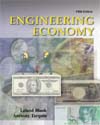Excel© Spreadsheet Exercises Contributed by
Dr. Jeffrey Adler, P. E.
MindBox, Inc. (formerly of Civil Engineering
Rensselaer Polytechnic Institute) How to use this section: Each exercise requires the development of an Excel spreadsheet. The exercises are keyed to sections in the text Engineering Economy, 5th edition, by Blank and Tarquin. Appendix A of the text is a complete primer for using Excel and the financial functions pertinent to engineering economic analysis. Sample problems are included in this appendix for setting up each function.
The spreadsheet exercises presented here are especially well suited to an engineering economy course with laboratory sessions or activities that help a student become more adept with spreadsheet-based solutions.
Spreadsheet Exercise #6 Project Evaluation: Present Worth, Annual Worth,
and Future Worth Methods Exercise Objective: This exercise introduces project evaluation for
sets of projects using the commonly accepted methods of evaluating and comparing
more than one alternative. Blank and Tarquin Text Reference: Chapters 5 and 6. Note to instructors and students: To correctly work this exercise, it
is necessary to understand the difference between mutually exclusive alternatives
and independent projects. It is also necessary to know how to correctly combine
independent projects to formulate mutually exclusive alternatives subject to
a limited initial investment budget. The limited budget topic is covered in
the first section of Chapter 12, especially Figure 12-1. It is suggested that
this material be briefly discussed in class and/or recommended as preliminary
reading material prior to working this exercise. Problem Statement: The ABCD company has four investment projects with
the following conditions: - Proposals A and C are mutually exclusive (that is, only one, not both, of
the projects may be selected for investment)
- Proposal D is contingent on Proposal B being selected
- The firm has $1,200,000 available for investment
- The study period or planning horizon is 10 years
- MARR = 18% per year
 <a onClick="window.open('/olcweb/cgi/pluginpop.cgi?it=gif::Investment Proposals::/sites/dl/free/0072432349/22712/ex6.gif','popWin', 'width=590,height=182,resizable,scrollbars');" href="#"><img valign="absmiddle" height="16" width="16" border="0" src="/olcweb/styles/shared/linkicons/image.gif">Investment Proposals (3.0K)</a>Investment Proposals <a onClick="window.open('/olcweb/cgi/pluginpop.cgi?it=gif::Investment Proposals::/sites/dl/free/0072432349/22712/ex6.gif','popWin', 'width=590,height=182,resizable,scrollbars');" href="#"><img valign="absmiddle" height="16" width="16" border="0" src="/olcweb/styles/shared/linkicons/image.gif">Investment Proposals (3.0K)</a>Investment ProposalsPart 1: Developing Feasible Alternatives On a worksheet, enumerate all possible combinations of projects. Indicate
which are financially feasible and which are infeasible. For those that are
infeasible projects considering the investment limit and other conditions,
provide a brief explanation.
Part 2: PW, AW, and FW Analysis On a separate worksheet, create a net cash flow table for each year for all
feasible alternatives. Add rows at the bottom of the worksheet and perform the following computations
for each financially feasible combination of proposals. - Present worth (Section 5.2)
- Future worth (Section 5.4)
- Annual worth using two different relations (Section 6.2)
Which alternative is best? Why?
Part 3: Evaluating Alternatives with Unequal Lives Consider the decision between two mutually-exclusive alternatives: (1) A&B
versus (2) C&D. Suppose now that we have different study periods for each
alternative: AB has an estimated life of 15 years; CD has an estimated life
of 10 years. Assume MARR = 10%.
Item 1 - On a new worksheet set up a net cash flow table for the two alternatives. Item 2 - Single life cycle analysis: Compute the PW and AW for the two projects
over one life cycle. (a) Which alternative is best?
(b) Explain the apparent contradiction in your results?
Item 3 - Compare the alternatives by the least common multiple (LCM)
approach. Assume identical replication of projects cash flows for each reinvestment
cycle. Use the present worth method of analysis (Section 5.3) Which alternative is best? Why?
| 


 2002 McGraw-Hill Higher Education
2002 McGraw-Hill Higher Education